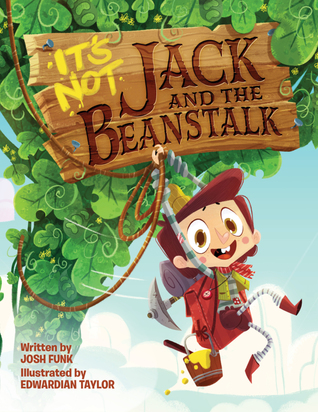Time to get ready for the weekend!
Kick up your feet and find a good place to read.
Sharing #booklove for your classroom or library.
Spotlighting a book or two because these books deserve the spotlight!
I've read a lot of fairy tales, fractured fairy tales and fairy tales that are very loosely based on fairy tales. It's hard to get the writing right because kids know when fractured fairy tales are more broken fairy tales and when those loosely based ones are hanging by a string. But this one has done everything right and kids are going to enjoy the fun twists and smart humor this book offers us.

It's Not Jack and the Beanstalk
written by Josh Funk
illustrated by Edwardian Taylor
published by Two Lions
September 19th
Josh Funk has given us a new fairy tale and added a whole new twist - a conversation between our main character, Jack, and the narrator of the story. It's Not Jack and the Beanstalk holds true to the most commonly told "Jack and the Beanstalk" story - Jack has been given magic beans for a trade for his beloved cow. The beans are magical and grow a large beanstalk. Jack finds treasure and a giant at the top of the beanstalk. But then our story changes due to a main character that breaks from his fairy tale mold (did we ever really know Jack?) and a narrator whose story keeps changing from the original format.
I think this story has many uses in the classroom:
- of course, as a read aloud!
- readers theater - work on fluency in a very fun way as the narrator and Jack have a battle of wits in this silly story.
- unreliable characters - is someone acting in a way that is different than you expect? How does this change the story?
1. How do you hear the characters talking in your head? Are there certain accents you use?
Actually, the characters REALLY talk to me. By that I mean, my kids would read the manuscript like an actual script while I was writing it. My daughter played Jack, my son played the giant, and I played the storyteller. We would often read it out loud at family gatherings and for friends. My daughter has always played the pesky youngster very well (whether reading this book or not). And my son does a great deep-voiced, slow-witted giant. And I just like whining and arguing a lot, which worked well as I played the role of storyteller.
2. How do you figure out how you're going to change the traditional tale - do you plan the changes ahead of time or do they come to you as you are writing?
A lot of it has to do with certain aspects of fairy tales that simply don't make sense. For example, trading your cow for a handful of beans? Are we supposed to believe that Jack is so feebleminded? Come on! Of course he'd argue with the storyteller. If an enormous beanstalk grew in your back yard, would your first instinct be to climb it? No! So Jack fights back in the hopes of avoiding this ridiculous task.
3. What made you think of having the narrator and main character go at it with each other throughout the story?
My goal with this book was to make the reader/narrator/storyteller look ridiculous. I wondered what it would be like if the characters in a book didn't do what the reader told them to do - and not in a 'the pictures tell a different story than the words' type of way. I wanted the characters in the book to actively defy the storyteller!
In short, I wanted to make teachers and librarians and parents and caregivers have to ARGUE with a book - and look foolish while they did it. Because I think kids like it when adults look silly. See how frustrated these educators get when try to read this book?
4. Tell us more about some of the hidden fairy tale treasures in the book.
Lucky for us, here it is! Can't wait for It's NOT Hansel and Gretel!
My students are in for a treat today because thanks to Two Lions, I have an early copy of this book! We are reading it today for #classroombookaday. Can't wait for the laughter to begin!
Be sure to pick this one up next week and share with your readers!


Can't wait to read this one!!!
ReplyDelete